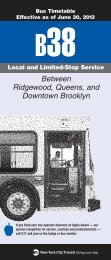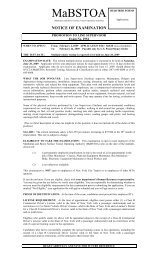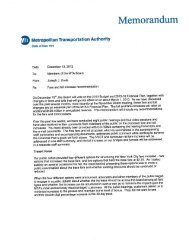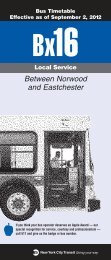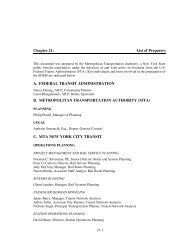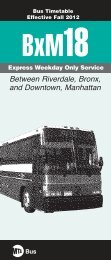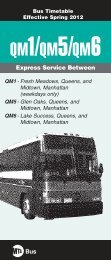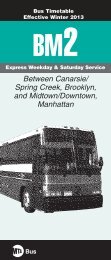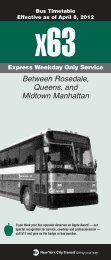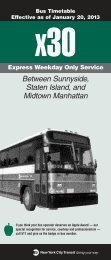Greening Mass Transit & Metro Regions: The Final Report - MTA
Greening Mass Transit & Metro Regions: The Final Report - MTA
Greening Mass Transit & Metro Regions: The Final Report - MTA
You also want an ePaper? Increase the reach of your titles
YUMPU automatically turns print PDFs into web optimized ePapers that Google loves.
72<br />
<strong>Transit</strong>’s Triple Bottom Line<br />
David Lewis, senior VP, national director, Economics and Financial Services, HDR Inc. and<br />
Stephane Larocque, principal economist, HDR Inc. and<br />
Justin Beaudoin, economist, Economics and Financial Services, HDR Inc.<br />
Pricing carbon avoidance is a necessary step towards a<br />
more sustainable economy and a natural part of <strong>MTA</strong>’s<br />
mission. For the <strong>MTA</strong>, this may eventually lead to carbon<br />
offset trades in established markets. For the present, the<br />
Commission recommends the development and introduction<br />
of a Sustainable Return on Investment (SROI) model that<br />
can be used to select green initiatives in a manner compatible<br />
with the <strong>MTA</strong>’s standard accounting practices (see first<br />
figure on p. 73). Akin to Cost-Benefit Analysis, SROI-like<br />
frameworks are already in use at a number of major public<br />
organizations, such as the federal Office of Management<br />
and Budget. <strong>The</strong> SROI is based on a standard economic ROI<br />
calculation (which accounts for the benefits outlined above),<br />
but factors in the estimated amount of carbon averted as<br />
a result of a particular green initiative, valued at the real<br />
opportunity cost of carbon.<br />
To illustrate, consider the hypothetical option of adopting<br />
photovoltaic technology to heat and cool an <strong>MTA</strong> office<br />
building. Under traditional ROI, the <strong>MTA</strong> might consider the<br />
capital costs of installing the equipment and the future costs<br />
of operating and maintaining it. It would compare the present<br />
day value of these costs with the present day value of the<br />
electricity saved. Unless the comparison of present-day<br />
costs and cost savings works out to a rate of return above<br />
the “hurdle rate” (or equivalent pay-back criteria), the project<br />
is deemed financially infeasible. Under an SROI calculation,<br />
however, an estimate is made of the annual quantity of<br />
carbon emissions averted by switching the building out of<br />
fossil fuels. This quantity would be valued at the real opportunity<br />
cost (say, $30 to $50 a ton) and the present-dayvalue<br />
of this saving (calculated over the life of the building)<br />
would be added into the ROI calculation. If the resulting<br />
SROI exceeds the hurdle rate, the project can be deemed<br />
worthwhile, even though it fails the traditional ROI test.<br />
<strong>The</strong> Commission sees the SROI model as a means by<br />
which the <strong>MTA</strong> can ascertain the value proposition of initiatives<br />
in each of the two recommended sustainability tracks,<br />
namely “greening the region” (through initiatives to increase<br />
ridership and transit-oriented development) and “greening<br />
the system” (through steps to reduce the internal energy<br />
and resource footprints of <strong>MTA</strong> facilities, equipment, and<br />
operating modalities).<br />
Rate of Return on <strong>Greening</strong> the Region: Although SROI<br />
calculations must be viewed with considerable caution due<br />
to uncertainty in underlying data and assumptions, evidence<br />
is indicative of transit’s potentially significant value proposition.<br />
Summarized in the second figure on p. 73, a 2002<br />
federal report found that the strongest transit investments<br />
are those which expand the reach of existing systems.<br />
Adding more nodes and interconnectivity among routes was<br />
found to generate SROIs in excess of 50 percent among a<br />
sample of completed projects. Investment in the modernization<br />
of existing facilities and equipment was found to yield<br />
SROIs of more than 30 percent. <strong>The</strong>se rates of return do<br />
not include the additional output and employment related<br />
to construction activity. As indicated earlier, building and<br />
modernizing infrastructure facilities will not necessarily<br />
create new jobs and income if the economy is already<br />
strong. But in today’s extraordinary economic climate, the<br />
$75 to $100 billion spending program contemplated in this<br />
report for period 2010-2019 could yield 105,500 net new<br />
jobs per year, employment income of $5.1 billion a year, and<br />
regional economic output of fully $17 billion per year. It is<br />
important to note that studies of individual projects indicate<br />
the possibility of much lower SROIs, some not high enough<br />
to warrant the investment. In short, every investment must<br />
be evaluated on its merits.<br />
Related evidence of transit’s value proposition comes from<br />
models of the economically optimal level of transit investment.<br />
Taking account of the congestion costs created but not borne<br />
by autos and trucks and the role of transit in abating such<br />
costs, one recent study finds that transit capacity (vehiclemiles<br />
and route-miles) would need to be increased by at<br />
least 50 percent nationally in order to maximize the economic<br />
contribution of public transportation in the United States. 1<br />
Rate of Return on <strong>Greening</strong> the System: Many of the<br />
near-term and transformative investments proposed in<br />
this report involve steps to make existing facilities more<br />
environmentally efficient. Two initiatives considered in this<br />
report, Examples 1 and 2, illustrate how the SROI approach<br />
can be implemented for system-greening initiatives in<br />
practice. <strong>The</strong> illustrations demonstrate that the SROI model<br />
may possibly justify some green investments that might not<br />
pass traditional financial tests. It is important to note that<br />
not every green idea will emerge as a worthwhile investment,<br />
even under the SROI test – SROI is not a green light<br />
to every green idea. Indeed, the Commission believes that<br />
green investment proposals, like all investments, must be<br />
subject to the discipline of reasoned analysis and benchmarks<br />
of success.<br />
1American Public Transportation Association, <strong>The</strong> Optimal Level of <strong>Transit</strong>, (prepared by HDR|Decision Economics), 2008.<br />
2Adapted from U.S. Department of Transportation, Federal <strong>Transit</strong> Administration, <strong>The</strong> Value of Mobility Improvements in Fixed Guideway <strong>Transit</strong>, May, 2002.



